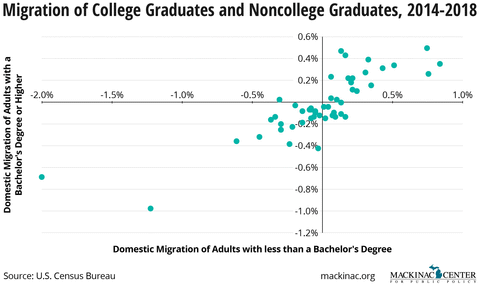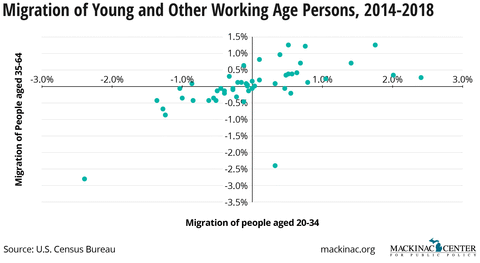Commentary
Michigan Wins by Attracting Everyone
College graduates and young people aren’t special

PxHere
Some say the future belongs to the cities and states that can attract young people, especially those with college degrees. Talented young people, they argue, are the fountainheads of economic growth, and therefore, the places that will prosper in the future will attract them. But the theory doesn’t hold up when you consider data about where and when people migrate. Michigan lawmakers should resist the temptation to create policies intended to target this population.
While Michigan was a magnet for people across the nation and even the world for a long time, the state population has been stagnant at around 10 million for the past 20 years. A look at population drivers shows what has changed.
There are two ways to become a Michigander: You can be born here or you can move here. Likewise, there are two ways to get out of Michigan: You can move or you can pass away.
Over the past 20 years, more people were born than died in Michigan, and there was generally positive international migration. But Michigan’s population was stagnant, because there was a strong outflow of residents leaving for other states in the 2000s and this only tempered in the 2010s.
Nevertheless, Michigan was able to attract from other states 203,900 adults with college degrees between 2014 and 2018. But another 223,800 adults with college degrees left the state over that period, according to the Census Bureau, causing a slight outflow of people with college degrees. That’s not all that different from the trend for people without college degrees, though. The state attracted 235,200 adults without college degrees, but also lost 271,500 adults without college degrees.
This is not unlike the rest of the country. The states that attracted more college graduates than they lost tended to attract more people without college degrees, too. And the places that lost a lot of college graduates also lost a lot of everyone else.
In the chart below, every state is represented by a dot and are laid out based on the migration of adults with college degrees (the horizontal axis) and the migration of adults without college degrees (the vertical axis). The line sloping upwards and to the right indicates that college graduates and noncollege graduates tend to move to the same states and away from the same states.

The migration patterns of people of different ages are a little different, too, but in a way that you’d expect. Michigan is bad at retaining older people. More people who are 65 and older leave the state than move to it. Michigan was able to attract 56,200 such folks, but lost 89,100 from 2014 to 2018.
But Michigan also tended to lose people younger than 65, too. Among those aged 20-34, Michigan was able to attract 283,400 people from other states between 2014 and 2018 and it lost 309,800 people in that age bracket over the period. Among those aged 35-64, Michigan attracted 205,540 people over the period and lost 228,912.
Michigan is losing people at all ages, but not as stark as the outflows of the 65-plus crowd. If there is a tendency, it is that younger people tend to move more, but that they move to the places where other working age people move.
There is a reason why people might be concerned about out-migration. It’s easy to notice when people grow up here but find jobs elsewhere. You hear about it from their friends and family and make notice when someone you know moves a long way away. It’s harder to see how many people are simultaneously moving in though. In Michigan, newcomers arrive in only slightly smaller numbers compared to those who moved out.
But this isn’t just a Michigan thing: Around the country, the migrating patterns of young people aren’t all that different from other demographic groups. It’s not as stark of a trend as the people with college degrees, but the states that attract the most people aged 35-64 are the same states that attract the most 20-34-year-olds.
Overall, the domestic migration of working age people tends to follow the same trend as those with college degrees. The states that attract young people also attract everyone else, and the states that lose people tend to lose everyone else. So, Michigan policymakers should focus on policies that attract the most people, not just a single demographic group.
|

Michigan Wins by Attracting Everyone
College graduates and young people aren’t special
Some say the future belongs to the cities and states that can attract young people, especially those with college degrees. Talented young people, they argue, are the fountainheads of economic growth, and therefore, the places that will prosper in the future will attract them. But the theory doesn’t hold up when you consider data about where and when people migrate. Michigan lawmakers should resist the temptation to create policies intended to target this population.
While Michigan was a magnet for people across the nation and even the world for a long time, the state population has been stagnant at around 10 million for the past 20 years. A look at population drivers shows what has changed.
There are two ways to become a Michigander: You can be born here or you can move here. Likewise, there are two ways to get out of Michigan: You can move or you can pass away.
Over the past 20 years, more people were born than died in Michigan, and there was generally positive international migration. But Michigan’s population was stagnant, because there was a strong outflow of residents leaving for other states in the 2000s and this only tempered in the 2010s.
Nevertheless, Michigan was able to attract from other states 203,900 adults with college degrees between 2014 and 2018. But another 223,800 adults with college degrees left the state over that period, according to the Census Bureau, causing a slight outflow of people with college degrees. That’s not all that different from the trend for people without college degrees, though. The state attracted 235,200 adults without college degrees, but also lost 271,500 adults without college degrees.
This is not unlike the rest of the country. The states that attracted more college graduates than they lost tended to attract more people without college degrees, too. And the places that lost a lot of college graduates also lost a lot of everyone else.
In the chart below, every state is represented by a dot and are laid out based on the migration of adults with college degrees (the horizontal axis) and the migration of adults without college degrees (the vertical axis). The line sloping upwards and to the right indicates that college graduates and noncollege graduates tend to move to the same states and away from the same states.
The migration patterns of people of different ages are a little different, too, but in a way that you’d expect. Michigan is bad at retaining older people. More people who are 65 and older leave the state than move to it. Michigan was able to attract 56,200 such folks, but lost 89,100 from 2014 to 2018.
But Michigan also tended to lose people younger than 65, too. Among those aged 20-34, Michigan was able to attract 283,400 people from other states between 2014 and 2018 and it lost 309,800 people in that age bracket over the period. Among those aged 35-64, Michigan attracted 205,540 people over the period and lost 228,912.
Michigan is losing people at all ages, but not as stark as the outflows of the 65-plus crowd. If there is a tendency, it is that younger people tend to move more, but that they move to the places where other working age people move.
There is a reason why people might be concerned about out-migration. It’s easy to notice when people grow up here but find jobs elsewhere. You hear about it from their friends and family and make notice when someone you know moves a long way away. It’s harder to see how many people are simultaneously moving in though. In Michigan, newcomers arrive in only slightly smaller numbers compared to those who moved out.
But this isn’t just a Michigan thing: Around the country, the migrating patterns of young people aren’t all that different from other demographic groups. It’s not as stark of a trend as the people with college degrees, but the states that attract the most people aged 35-64 are the same states that attract the most 20-34-year-olds.
Overall, the domestic migration of working age people tends to follow the same trend as those with college degrees. The states that attract young people also attract everyone else, and the states that lose people tend to lose everyone else. So, Michigan policymakers should focus on policies that attract the most people, not just a single demographic group.
Michigan Capitol Confidential is the news source produced by the Mackinac Center for Public Policy. Michigan Capitol Confidential reports with a free-market news perspective.
More From CapCon